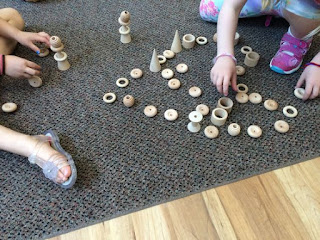It’s that time of year when teachers start to focus on
children making things – holiday and seasonal decorations and gifts to display
or to take home. Often the goal of these activities isn’t about children’s
ideas or children’s experiences, it’s about requiring children to make a
product that can be displayed to or given to adults. These products usually
involve some template or design chosen by a teacher, with clear directions so
what the children will produce will look “nice”. “I know this isn’t very
process oriented, but the parents love it,” I heard a teacher say.
Is that the purpose of early childhood education, for children to follow teacher directions to make something the teacher thinks parents will “love”?
The purpose of art activities is for children to explore different materials, and experiment with their own creative expressions. What they make should be their own, not a reproduction of something a teacher was captivated by on Pinterest, or that the teacher has decided she wants children to make. We need to value children’s art as art – not as a means to create a product for adults.
One way to do this is to make a variety of art materials open and available to children
daily. With toddlers and twos, it’s best to introduce one or two materials at a
time, to allow them to explore their properties and give them a scaffolded
experience in making choices of what to select. Children this age also need
repeated experiences in figuring out how
to use a material. Gluing paper seems easy to an adult, but it requires many
steps that take time to figure out and practice. How do I get glue onto the
paper? How much glue should I use? How do I make the thing I want to stick hold
onto the paper? How many things can I stick on to this amount of glue?
Once children have had the opportunity to explore and
understand basic materials like glue, paint, paper, and scissors, they’re ready
for more choices. Setting up a table or art area with a small variety of
materials can help them consider choices and continue to develop an
understanding of the physical properties of different materials and objects.
And then when they’re ready, they can choose what materials
they need, and how they’re going to use them. This is Art. They don’t need
directions or templates or an example printed out from a webpage – they just
need room to create.




















































